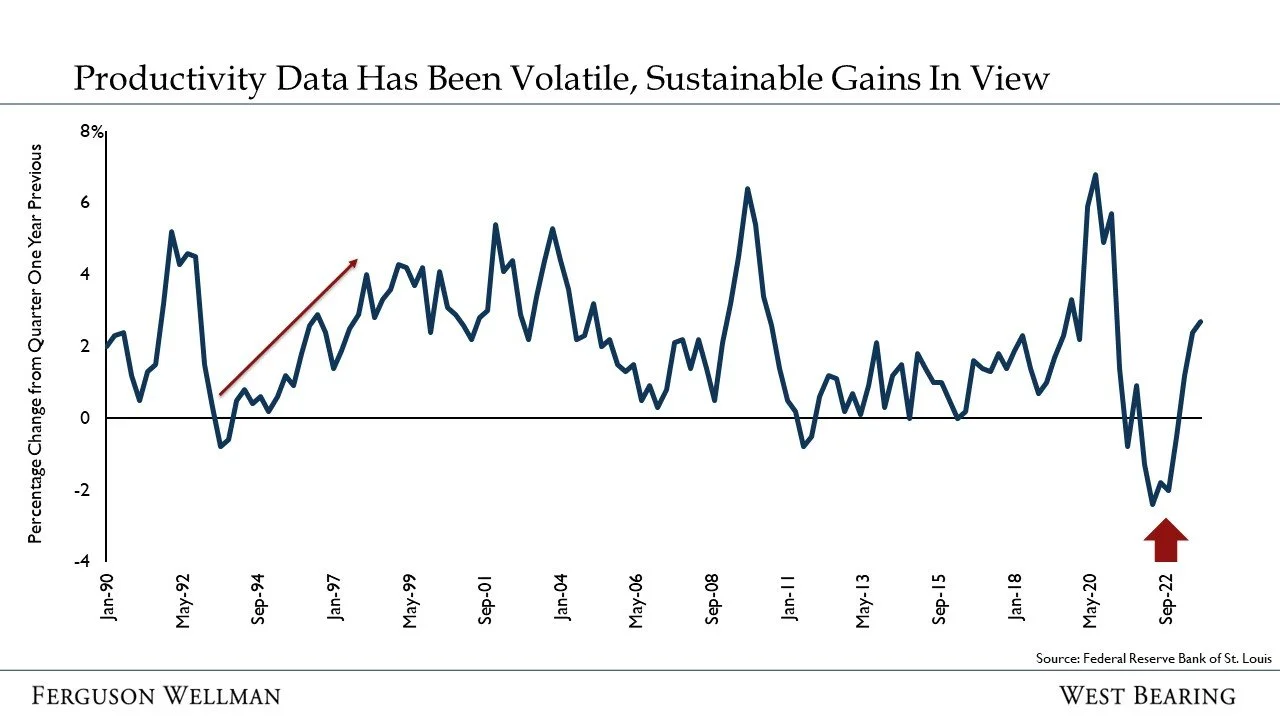by Jade Thomason
Equity and Fixed Income Trader
By March, our feelings of excitement for a new year have generally worn off and we have settled into our winter routines. The hope of an early spring and longer days are normally what carries us through the season, but this year, more excitement is brewing. I don’t know about you, but 2024 is off to a “buzzy” start. At the time of this writing, the S&P 500 is up 6.8% year-to-date, and much of this rally is fueled by artificial intelligence (AI). Artificial intelligence has taken the market by storm and provides seemingly endless possibilities for both innovators and adopters. The landscape leaves many drawing parallels from the mid- 1990s, a period of rampant innovation which led to productivity gains that enabled healthy economic growth. Should we expect a similar trend in 2024 and beyond?
Productivity in the United States grew rapidly in the mid-1990s due to the adoption of new information and communication technologies. Manufacturing improved and computers became cheaper, allowing businesses to make larger investments in information technology. Of course the aughts and 2010s also saw innovation however, despite the access to widespread, rapid internet connections, mobile devices and cloud computing, productivity gains were tepid. Today, we are seeing the beginnings of more sustained productivity gains, similar to the trend from the mid-1990s.
Artificial intelligence has the ability to promote automation of menial, day-to-day tasks and free up time for workers to spend on what propels business forward. This will not come without challenges – a change in how we do our jobs will inevitably lead to a dislocation in the labor market as workers who performed those jobs will be displaced.
Artificial intelligence is a broad term that is relevant to many industries, making it difficult to conceptualize and apply to “real life” scenarios. Healthcare is an industry that all Americans interface with, and I am sure many of us can pinpoint aspects of the healthcare system where we would like to see improvement. A common headache is the wait time – patient wait times have increased from 21 days in 2004 to 26 days in 2022 and an astounding 75% of Americans will go to the emergency room because they cannot wait for a doctor’s appointment. A top priority for healthcare companies is to improve access to care and streamline the process, so that doctors have more time to dedicate to patients. An issue on the physician side is the administrative burden. In an average working day, physicians spend more than 50% of their time completing administrative tasks on electronic health care records. Increased automation is at the forefront with AI-assisted electronic healthcare records which will provide tremendous relief and will ultimately allow for more patient-centered care desired.
The above case study using one industry provides insight into the power of AI, and how its application can transform how we work. The productivity gains we have seen in the past year may be just the beginning and could pave the way for sustained economic prosperity.
Takeaways from the Week
Headline personal consumption expenditures (PCE), the Fed’s preferred inflation gauge, was released Thursday with an increase of 0.3% monthly and 2.4% on a 12-month basis, as expected.
Fun Leap Year Facts
The Dow was higher 67% of the time a month following Leap Day and after three months it has been higher 56% of the time
Leap year outcomes show stocks have gained for 14 of the past 18 leap years
(Of course, past performance does not indicate future results)


